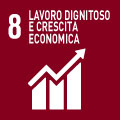- Docente: Fabrizio Palmucci
- Crediti formativi: 6
- SSD: SECS-P/11
- Lingua di insegnamento: Inglese
- Modalità didattica: Convenzionale - Lezioni in presenza
- Campus: Bologna
- Corso: Laurea in Business and Economics (cod. 8965)
-
dal 10/02/2025 al 16/05/2025
Conoscenze e abilità da conseguire
At the end of the course students will be able to understand and apply the main financial principles and concepts: they will understand why and how financial intermediation exists, how the basics of mathematical finance should be applied in the evaluation of financing contracts and financial instruments; how to invest in a portfolio, taking into account both expected returns and risks; how the monetary policy is related to what they learn in this course and how to interpret the current issues on financial markets.
Contenuti
This course offers a comprehensive overview of key financial principles and concepts. Students will be able to understand why and how financial intermediation exists, and how the basics of mathematical finance should be applied in the evaluation of financing contracts and financial instruments. Moreover, they will learn how to invest in a portfolio, taking into account both expected returns and risks. Finally, they will see how the monetary policy is related to what they learn in this course and how to interpret the current issues on financial markets.
Structure of the course:
- Financial Intermediation
- Time Value
- Internal Rate of Return 1
- Internal Rate of Return 2
- Internal Rate of Return 3
- Capital Budgeting 1
- Bonds Market and Valuation 1
- Bonds valuation 2
- Monetary Policy
- Chapter 6: choosing the appropriate discount rate.
- Chapter 8: Risk in finance
- Chapter 9: Part A - Portfolio Statistics
- Chapter 9: Part B
- Chapter 10: Efficient Frontier - Part A
- Chapter 10: Efficient Frontier - Part A
- Chapter 11: Security Market Line
- Chapter 11: Security Market Line
- Chapter 12: Investment Funds' Performance
Testi/Bibliografia
Benninga S., Mofkadi T., Principles of Finance with Excel - 3rd Edition, 2017, Oxford University Press
Teacher Handouts
Metodi didattici
The main instructional approaches used in the course are:
- Lectures
- Problem-Based Learning
Modalità di verifica e valutazione dell'apprendimento
Component Weight (%)
Midterm Exam 50
Final Exam 50
- Partial/final exams structure:
Mandatory written exam (computerized):
- midterm exam: 30 points available. It consists of 3 multiple choices (1 point each) and 3 exercises (10 points each)
- final exam: 30 points available. It consists of 3 multiple choices (1 point each) and 3 exercises (10 points each)
THE EVALUATION DEPENDS ON THE correctness, completeness and rigor of the answers.
- Exam policy:
Registration on AlmaEsami is mandatory for both written exam sessions.
It is possible to reject the grade of the midterm and take the final exam. It is also possible to reject the final exam’s grade one time.
Fractionary final grades obtained in the written exam will be approximated to the superior unit above 0.5 included, and to the inferior unit otherwise.
The (rounded) final grade can be refused only once.
Grading scale:
< 18: failed
18-23: sufficient
24-27: good
28-30: very good
30 e lode: outstanding
Erasmus: at most 20 Erasmus and Overseas students, and 10 UADE students, selected in chronological order, will be admitted to the course and the exam.
Students with disability or specific learning disabilities (DSA) are required to make their condition known to find the best possible accommodation to their needs.
You can test the exam platform here:
https://unibodisa.eu.qualtrics.com/jfe/form/SV_9zDRvwzDHwpv1v8
Strumenti a supporto della didattica
Tools, platforms, or resources used during the course:
- Learning platform: Virtuale (virtuale.unibo.it) contains the slides and the team-work assignments
- Presentation software: PowerPoint
- Communication tools: Email (course’s specific mailing list); Teams; Forum on Virtuale
- Other digital tools/software: Excel
Orario di ricevimento
Consulta il sito web di Fabrizio Palmucci
SDGs


L'insegnamento contribuisce al perseguimento degli Obiettivi di Sviluppo Sostenibile dell'Agenda 2030 dell'ONU.
